Arlington County, Virginia Keeps Election Workers Trained with Slideshow Refresher
This story was featured in our ELECTricity newsletter in February 2019. Sign up to receive more success stories from election offices across the country. And how is your election office using technology to run excellent elections? Tell us about it by emailing [email protected] — we’d love to share your story!
Recruiting and training poll workers is a major focus for elections offices, and for good reason. There is a national shortage of poll workers, and the quality of training can make or break the voter’s experience.
But training poll workers is one thing. Keeping them trained is another. Some poll workers are trained weeks before Election Day. Returning poll workers often skip trainings entirely, since it would be a waste of time for veterans to spend hours relearning the basics. On Election Day, even well-trained workers struggle if the training is not fresh in their minds.
Arlington County, Virginia keeps their election workers trained with self-paced slideshows that workers can complete in 10 minutes or less. The slideshows include built-in videos and quizzes to test workers’ knowledge and preparedness.
Supplementing In-Person Training
The vast majority of Virginia counties (around 80%) have fewer than 50,000 active registered voters, making Arlington one of the largest at over 150,000. That number is expected to rise as the population continues to grow. Arlington just appointed 1,200 election workers for the upcoming cycle, and has prioritized online training supplements in its strategic plan.
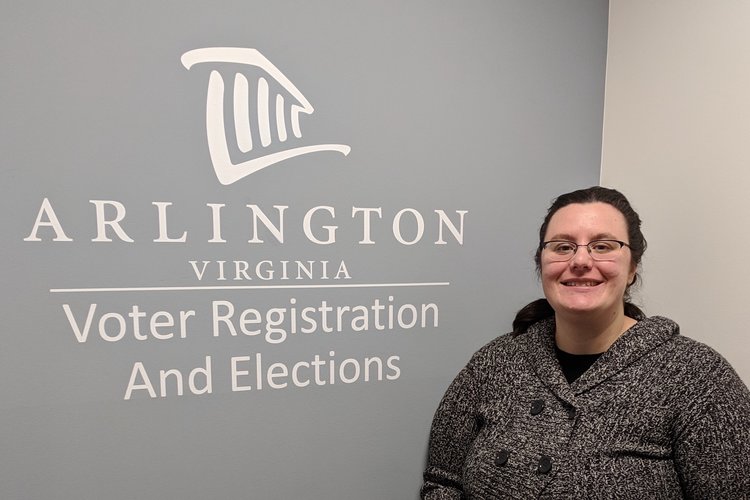
“Large localities have to start training workers several weeks before an Election,” explains Gretchen Reinemeyer, the Deputy Registrar of the Arlington County Electoral Board. “This solution offers workers who attended training at the beginning of the cycle a chance to review the materials immediately before an election.”
Arlington’s slideshows are meant to supplement, not replace, longer in-person trainings. They act as pre-Election Day refreshers that workers can use to review the material. Workers move through the slides at their own pace, reviewing exactly what they need and ignoring what they already know.
The slideshows include normal slides, slides with YouTube videos, and quiz slides. The YouTube videos review complicated procedures like voting machine setup. The quiz slides are important for two reasons: 1) Election officials can assess their poll workers without using an online portal and logins. 2) Quizzes help prepare poll workers. According to memory retention experts, quizzes and tests are better for your memory than traditional studying.
Creating the Slideshow and Quiz
Making a slideshow interactive takes longer than assembling a basic presentation, requiring an additional 2-4 hours depending on the length. Gretchen advises patience. “Be prepared to mess up and have to start from scratch. It takes time to learn, implement, and test a new technology.”
Despite taking longer to initially prepare, the slideshows end up saving Arlington County time. They spend less time assessing workers, since the slideshow acts as a preparedness test, and they spend less time doing in-person trainings for returning workers. Gretchen calls it “a one-stop solution for training and testing,” easily worth the couple hours it takes to prepare.
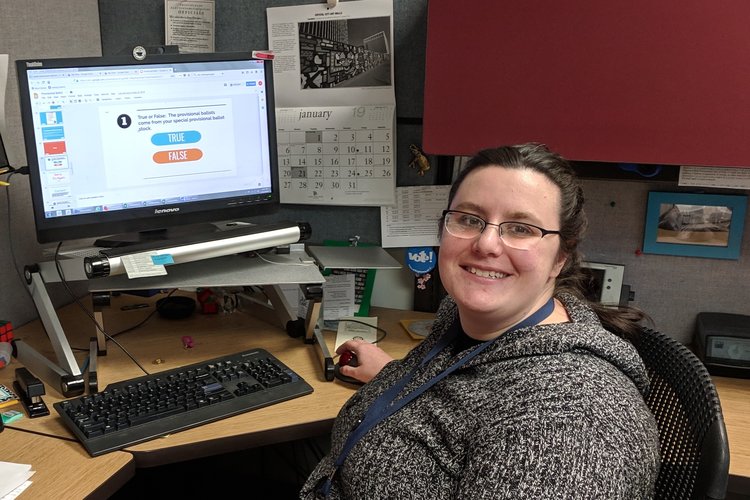
Arlington County uses Google Slides, a free online tool for creating presentations. Microsoft PowerPoint will also work, but PowerPoint costs money if your office does not already use Microsoft Office.
For complicated procedures, like how to operate voting machines, videos that walk you through the process are incredibly helpful. Google Slides lets you embed YouTube videos directly into the slideshow. Watching the videos is optional, allowing workers to decide for themselves whether they need a review.
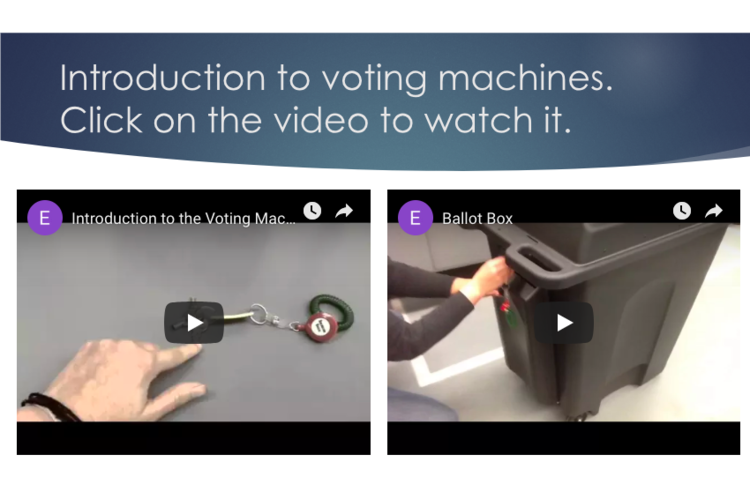
Building the quiz questions into the slides is the real “technology hack,” according to Gretchen, and other counties have already begun asking how she does it. Workers cannot move forward in the presentation until they click the correct answer, and they must answer every question correctly to get credit.
To create a quiz, you need 3 slides per question: the question slide, the wrong answer slide, and the correct answer slide.
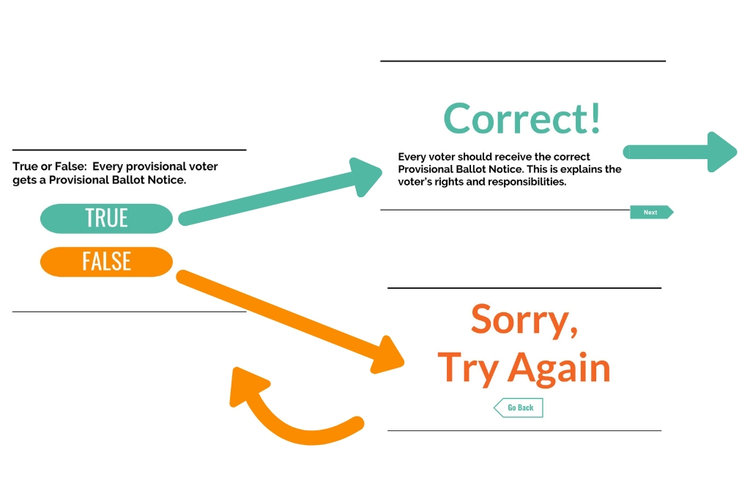
Just like you embed hyperlinks that take you to a different website, you can embed hyperlinks that take you to a different slide. In the above example, clicking the “TRUE” button takes you to the “Correct!” slide, and clicking the “FALSE” button takes you to the “Sorry, try again” slide.
Normally slideshows move to the next slide if you click anywhere on the slide, so you need to lay a transparent box over the whole slide, and then hyperlink it to the current slide. This way, election workers can only move forward in the presentation if they actually click the correct button.
At the end of the presentation, a webform link lets the election worker provide feedback and get credit for the training. Webforms conveniently don’t need accounts or passwords. Google Forms is one good free option.
Listening to Poll Worker Feedback
Developing this solution took experimentation, trial-and-error, and listening to feedback. Over the years the office tested several types of online training, each with drawbacks. The first system required workers to log in, but creating an account and remembering a password is inconvenient, so the completion rate was low. Next, the office allowed workers to test out of training. Returning poll workers were glad to skip in-person training, but wished they had some instruction.
This feedback helped the Arlington office shape their hybrid method, a combination of testing and optional review. Feedback on this method has been “overwhelmingly positive,” Gretchen says, because workers find it “clear, concise, and convenient.” After completing the training, 92% of respondents feel confident they can perform their duties.
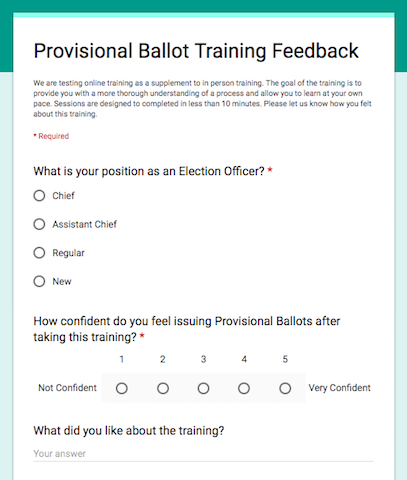
In the future, Arlington will expand their library of slideshows to cover topics they don’t have time to cover during in-person classes. Again, the office will rely on feedback to decide which trainings to add. They were surprised to learn most Arlington workers want a review of Federal and State Election Law. “Listen to your workers,” Gretchen says. “They will tell you what they need.”
Quiz Example (3 Steps)
STEP 1: Make the background unclickable.
Google Slides automatically moves to the next slide when clicked anywhere. To prevent this, place a large transparent box over the entire slide. Then, on that box, insert a link to the current slide.

STEP 2: Make buttons that link to other slides.
Add shapes and text for every answer. Then, link each “button” to the appropriate slide. Create a “Wrong answer” and a “Right answer” slide for each question with buttons that link forward (if correct) or backward (if incorrect).
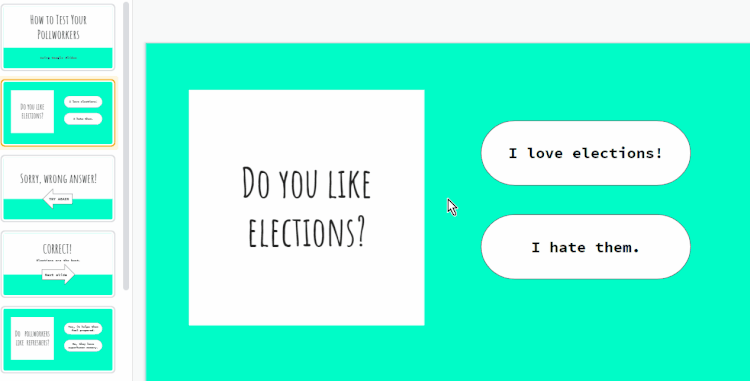
STEP 3: Test your slides.
Test your slides! For every question, click the wrong answer(s) first, then the right answer. Make sure everything works the way you expect!

Additional Resources
If you have questions about Arlington’s presentations or need advice for making your own, you can reach out to Gretchen by emailing [email protected].
One of our professional development courses, Poll Worker Management Best Practices, goes in-depth into recruiting, training, coordinating, and evaluating poll workers. Additionally, the Center for Civic Design has a Field Guide on Effective Poll Worker Materials.
How has your office tackled the challenge of keeping election workers trained? Tell us about your experience by emailing [email protected].